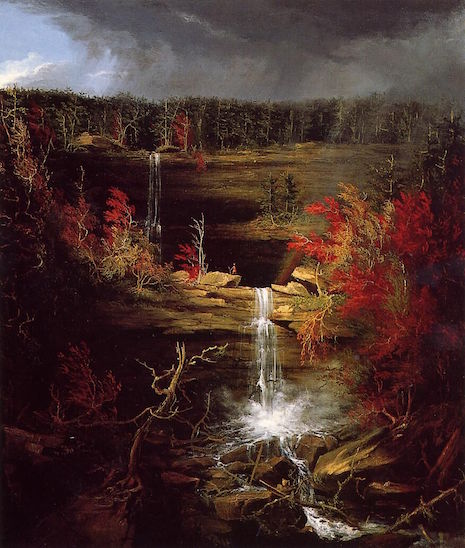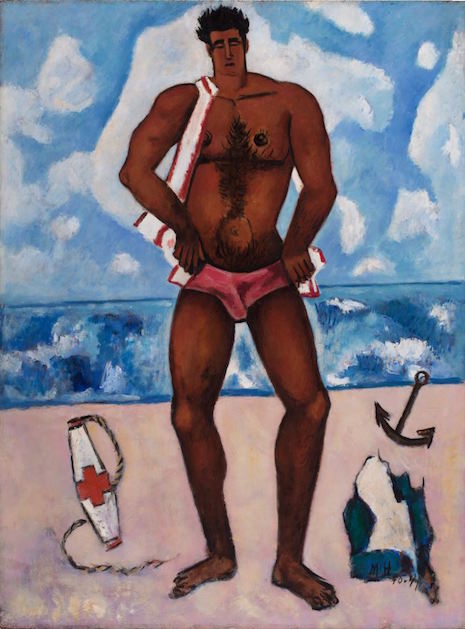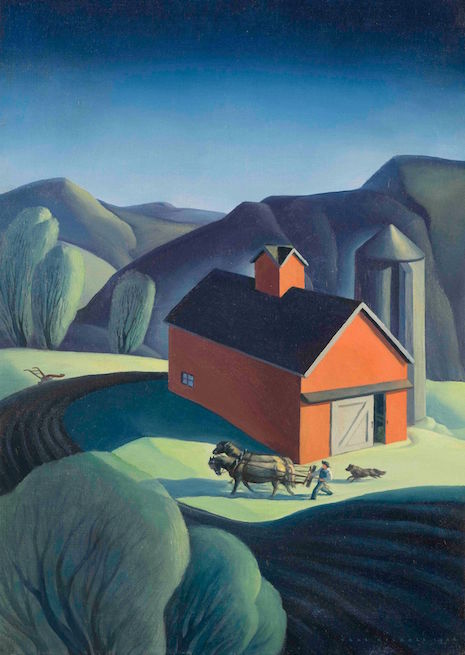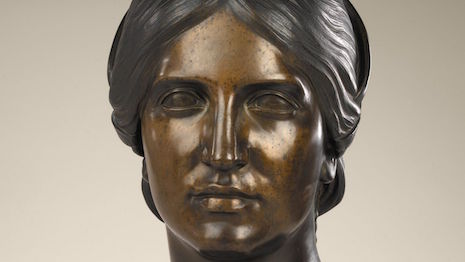Initiatives in Art and Culture May 19-21 in New York open the 22nd Annual American Art Conference with the catchy trifecta theme of “The New: Modern, Modernity, Modernism.”
The conference, hosted by IAC founder/president Lisa Koenigsberg, will be held at Sotheby’s New York at 1334 York Avenue at 72nd Street in Manhattan, with events at the Conner and Rosenkranz and Hollis Taggart Galleries. The conference program is designed to understand what it means to be modern over the centuries, starting with Thomas Cole in 1824 to the early and midcentury movements and now with works from the 21st century.
“[The logic is] to begin with Thomas Cole who was startlingly modern in his day and to move forward in time focusing on the emergence of modernity and then of modernism – discussing developments in technique, composition, subject matter and materials, as well as in framing, approaches to the conservation of art and in artists uses of new technologies,” Ms. Koenigsberg said.
 Thomas Cole's rendering of Kaaterskills Falls, number 2
Thomas Cole's rendering of Kaaterskills Falls, number 2
Besides Cole, topics under discussion include modern bronze, John Graham, American Art in 1862, Ralph Albert Blakelock who was considered the bridge to Modernism, Kami of the Japonesque Taos paintings, rural life meeting Modern Art, collecting Modernism, framing 20th century, Frank Stella and erasing boundaries between artists and conservators.
Here is the dialogue with Ms. Koenigsberg. Please read on:
What's the theme of this year's American Art Conference?
The consideration of the new in American Art and the differentiation between the terms Modern, Modernity and Modernism.
How is it different from last year's focus?
Last year, the conference took a deep look at both recognized masters and the works of artists that did not retain the renown they enjoyed during their lifetimes, as well as cycles of taste which account for the ways once-forgotten artists and their largely unknown works resurface and startle us today.
Have you noticed a change in the art market in the past 12 months that is a harbinger of things to come?
Great stuff – superior examples in excellent condition of highly recognized American artists – does well.
The market for strong works and fine examples seem to be vibrant, whereas works of more middling quality seem to be doing less well.
More works by what might be termed rural modernists and Park Avenue modernists are surfacing.
Additionally, works by those once or twice removed from the core of the Stieglitz group are more prevalent.
More works on paper and preparatory works by major American artists are also appearing. There are important opportunities in sculpture.
 Canuck Yankee Lumberjack at Old Orchard Beach, Maine, by Marsden Hartley, 1940-41, oil on masonite-type hardboard, 401/8x30 inches. Hirshhorn Museum and Sculpture Garden, Smithsonian Institution
Canuck Yankee Lumberjack at Old Orchard Beach, Maine, by Marsden Hartley, 1940-41, oil on masonite-type hardboard, 401/8x30 inches. Hirshhorn Museum and Sculpture Garden, Smithsonian Institution
What is the state of American Art?
IAC is committed to raising the level of interest, enthusiasm and activity in American Art to that seen in the wake of the bicentennial.
You have a catchy subtext for the event: Modern, Modernity, Modernism. What was the idea behind that?
The idea is to differentiate between three terms that in common parlance are often used synonymously.
What was the logic behind the program?
To begin with Thomas Cole who was startlingly modern in his day and to move forward in time focusing on the emergence of modernity and then of modernism – discussing developments in technique, composition, subject matter and materials, as well as in framing, approaches to the conservation of art and in artists uses of new technologies.
The speaker list has must have been hard to put together.
Our goal is always to secure the best possible speakers ranging from those who are established figures to those fresh voices with important new perspectives.
We also seek leading authorities from every aspect of the American art world, including such realms as conservation.
 Spring Turning, by Dale Nichols, 1946, oil on canvas, 25x18 inches. Private collection. Copyright Joan Nichols Lenhart
Spring Turning, by Dale Nichols, 1946, oil on canvas, 25x18 inches. Private collection. Copyright Joan Nichols Lenhart
What should the conference attendee walk away with after two days?
An understanding of Modern, Modernity and Modernism in American Art as well as invigorated enthusiasm and passion for the field.
Please click here for more information and registrations details on IAC’s 22nd Annual American Art Conference themed “The New: Modern, Modernity, Modernism.” To get $100 off, please use promo code LUXURYDAILY
{"ct":"ZeNA7b9PqnD+6HDVx10M6F\/7VfYiTWe7MnUJNUpDZJLnR\/IBv6gU+umaIw4pcUYaugINGYHGH5WV7O3XXe4WTu6bRSykH\/QqNE8TMkuKmp9FZ35JbO+ir7iEnJpwtgsaEeU4UoO5JmehMx6H0HmdA1DyimQ1JIsmZVqb0GQnImixO+meAZ7qtW53ebT1HXuxtr1osGD0Nh+jCkqVX2w67VAjdS707c7Dw\/yA8ZOskzPfyRGfBJX0VaB8h5vJ9PppLUAa3+n5i6+xaauqMg22PPr1N0Ad3HPXUZ5CHYG4R+dv2ZXSbXHcJ4pJFdDyZV29aHrxuqFU6kCw8DbGJua+nY80XHbCnlYG5bjc\/HRW7rxbRlgKHhmEK7XvYQgwJ\/oP8cPr+wK9nqRXZIYmTFeHB2mWhsAnQLKEd9oXCOMR3OTU8RTzof6uyglydFe358jdMDmf63I+bTre0Z9otU66N0DbMXczXlGkYe0GwF6ine9P0RO+Q7vZhS98Hagf0\/wJBFowGHKfTQ8UiZxKeEy2+Ohw4mIbiHohDwKugmO84h4tWGkKCnAgt1sxBlrwpCIeTjK515m5ZBgMF8Ai8GzmWdgZGz5\/kC8Sg6uF2v6B+\/Ikrh0aykhABLc\/gh\/j2kkcsiq7VF4SjVTCnmpy65iWmVF7wh\/zO\/Dd9y9a\/KZsHPhJj+hb0RPaPOOgCIIXv7RKYre\/BxEQTBhU7ITwibPaEJryjjhV4wKjEtYTNq7nL+j1CjDf1q0IUX1dKthbxKArhCMqWhWGauPi3\/AbviGleQXWJr82pjWeG3p\/REpk2gHDzT8MizJ1VmYIWiPyB6MP7R4WeVbCPDn5DUZK70DSOrM8tew8P\/YLtJ+bVFxF3bJBRy00Ms\/ZmATcjStAeszJjTVRi8L81MfEj49PdM0OSdm0v14+2VDYeHoz6FgAoBubBa8aYOzGGYkvbFAksvNyb4fWNnMYrWdx9vgh9IT5pOh8hep08Cpe5HqstkFWSPMfp1SrMRmrWK2sCkcOqJc8k53ksrrMW\/rzLllhCfa6R6iF+0Dc0DY8Mu6vfXwDwnvZXlEiOj9M7gmzDrgDk2h8etNgE+sBkg4KD+HhWg3u4QhONmZiCTNshv16F7n3glvGSP52HqlCFwMkMaF47bGPpzKWXUzHpKrYftOWnBqpQi4eQKK2lC401MU0VHRYGlgcIW79Zv0nL9A35aEyEpue2EzYi1KNFoG1lP6xtizKLeFZoyKEtwPA\/MYwE\/AM1CAC3M1wjyXzDSTsz49Ex1iAb9RUTs8rcf01bNTLF2IRIgFHIfSJqBOtEC0nV7BFila48XimN9lc2xxKaykZXd1q0U3A2sbkoKe7GdeWxc9fBnLDoE2SySKZtAJt8R3oAvA8A7vHTy1RPphVUh1oJR57cJg7zTxZ6I\/Aa80Ivc0bFJ2ruwlK6zN1o3LXAKb+psMaqShr8Bueg3a+KXFnzBxIjzwkvobpnzN5ZW2DxCKZcUdVMSW\/Nr1ew61NCJnKe2aGiNAe+7DTt3ErY49LvgISUHzsD86yLCwuokU18q6N9YDld+ISyMDqiM2TTDa18IpKc4jAREQVRBx0EpnlOntgocYVT1AbF0O8DWcdMgAvOeBb52YNoquDQTrsU\/6VvTuy\/WEaN6MuYtRHoZxdCxB7trqCyxHAoZg\/mMs+nTw34YPkCEMx63JnfB7ROpHp383MOuokou2\/TYzqSHOV13nXfyh7Jxaee5vHmQZ3FzI+ff\/hHS12VkiiYsssVgpackph0DJXgB5S\/5DzYHGBmCNUJXebOCbaTyVaaEKJHoIif3kV6zJHSNpj\/0pZ+uEIUhP7e\/dgmhBBUdShwuV43Avqpq7pJeQST583O4bWtS2p1\/IvMk6C4FyDMWpahfPVp1Kz5DU2OY5ZS2rbizbJE4u3EeUgq8m9h0vvsEk+LJ23BKx15Ia06H\/QLolZGZEyM9pl7Au2K84NdPHaTCFFWreXmTSaFTMesxaNnNTsjlyTLJRR+C5iUaRo9X4Q2LqT\/gTNrGQVCz3Up7EnF92QZsFTNxwg0oyHzhp1Z\/Vzag2oA8BoQc3dfM\/d855SQTZatOHcyAzeINCGXVbUsz2j9UGz80rSXJhX6es7kYzbxPvKtJpcaybrqkAzWGKvenometbE0SRsgj199jvfETMatpypkWNKhYbP1SAOYv9Qu54k\/eecz+QKJiCyZ4cOE5hjA9LjmSvfEuiUlRmK4kd8AigvLdHLo6VTQ20gFlvpuxj6UpLtAEYNYYrhSgxGg1MeGfYd1tVVHIRujM0XY2DrWz2Z13R9PGtPIJ4cRoothkT5Qj3lTHQ1KFF5Dphau1CyTodc1+d1Ze1A8j0L3jHhv+F6qCKrG4UXGDwZ6txKcCbxqZB2HzHFuVZW6\/iwIRBV5Jwj9AAQz3X88+qUmqh+Ou6FyS2sF8vG2Ywz0AkZ0rTVYuB9WlZnjuTO6NlJrtIjlG1gLuu5li\/ZLiC1gEXUoDtm24aiPoVqdvhpVpT7SCjVg+TJLH0b\/7vjmF\/+4zbJb3e83z59cJfENyETAB1qOLouXDeVEIV3jg7G6FPS8bzoVsKRpq0m8pChM1cSYH2OrhTmhCF+30uHcAYGWVTrjKDZHn1eg4r\/CFtZPaozoFXztDcUphpnBm6D3wKn3yPwxUfj1BJeE\/KYAQnVCPIr0JoECp7lV2RRIU4X5q6O6Hj7lYfI+hwdrNekxj7QI3ShHoMzd5QQozf\/1pZtGhtclGFNcVI6Vkd6QVOtwzLtdJ1NvCUGHzxBbAh0XmiXjLjHKXClTptUvULGIfS8ZGjZSk+2IA+tVzZs2ZfGEvoyQW7rnsFMkcqZdWEQDg765Vi3UTYjPYUdSvEldGrwbRS\/yPHHEEDjLg7k1KweTgYBpayweq+HkOPLb78u8\/jqMnEYL+tmAkYXLCrIOOBtJ+AW7GO0LFIaiSqQtkKM4649aSFM0d8ksSgWnx9rYdEYd1iATWKKxc7RQffWYz\/kp\/Re5CFyzHapkhCFh8DsM6ZOj0LE3va+NlLGiGXFRCsTQ6TviAkGqucakEwe7JmUaqcC5pguCHtD1YEV3SOq7FqEG0kQce3Y7FRgR0GK1DTWPf3I+9Dwv6dXKbrLKA1Uw+2k7ucgrhEwJYbJK+LDWmbjaP0deapzBXQmP93\/qPnYMTi2Ds6WS8zNr7+1foP08zXOqC3nfcZT0T5Q2D9d9fvDCrH9MOjqTNazLZ8pOS9C9F0WtNdhuFUZ3fXu2lTB6dBkk4U2Td7Sgu\/SQER561CMU6qVjmLinbFAI0aTZRgzbiI9v6NRa5Q5L\/I28DRfR+dPFRqeDKmzaGSJET4lE1weWNDyS6HdOfO1ojnUNFYzc96NSMmDXKxadxpvk1HDV8z76fL8GcV\/WqH30Zk+ykzHeSKEz34MiuUNleObi7E\/5C\/dzPIHecLkJOtiBrvtIlFyd3VH+l46Z\/SUarw26ojT5ou822nuGEYHAsVsx2mI3uUR0d7+5r3\/h9Kt61ImyZ7qtAZCfj0NllUaEsMuQfapGePaZzLLCLoq7iL9xI04bFMeirXsKI6XCQrwCmmCRCECI0LWhH9iM2cNBP7I+GcDga7YXP+IEa5LNQkdr9XXJxVi\/EKYf9j0fRru2PtpQkoYfll1LuxIiggIbJMCyRjmPQnCRjPa7tJ7m7iTjrJq6v7DD9uqrdXC4A22j7urhfeirMgx9pEXRPQnxPst4YBbMk1hvIatkMUO4RjFoQWqXOWvaRCB6eIWWPUWrHMqa7G3LnTPrt4YTp+plYhw6dRNip8RmjNhIw29y+9B+85LfHddMzzP1PcMygrB6acL7Fk9xd3zvo+RzGU7wFrrg4eELNyCBgV937sFqcxnJ6gCyOQKWNJPnUOoAIZR0biofTmfPggFDyZXAg9m24RXndWb22vJdnWBHFE34Wc9XO\/IMTK3PM4g8TcIMXu\/R6KfVtxHhDGbTONi9Ys8D3EGRZYvR4PzznJb\/PdDH\/CQKzrDIYVWDrrqf4if2J9QHnWZEBTLG9Z18aaY+GsgZ4O1dNFnq+jLh7EaiLnsEW7EM41If\/0jCrx4jorZ1u99nXHs2CL5hiQtOq5OKghUgBzT9AQI7PY0RlMIj\/eBC1zotEKb9wGXuPhZZPp1nkOCfgigage9grW776KDNznqqGgivy2Rf3SXqy58S58WtNCbZe+rneLFNTPK9lMzHzSQe9HK\/\/8NW0DXPmbPY0\/32EeFaKU0Vt\/7h6wJ2tG421k8JKatVFzbXT4UnVGAhzJRnbmTl+SpAziyhakx7lojQy1I9ann73fd6++1pSngB1oY5qK6aXH9BBRwPC+JSCzYT3ExECiWVaCd7iFw54PpLFD\/p16dRpYPIx+FPifeMZh+pIo\/WDsHAUnjEur8s\/kHZ4vYAc3fPBF0ewfDw\/j6Cu8UDw6Banrxcri\/xsqNfiZaCM4kpRh4HO6KvrbN4j2Du6j6jtdEBOQ9qgHt92L4oVIC8sjLFubm7z1ugZ98WSyrYkXHTaECqsUqzIzYlHr\/hG8gipy+5rPJ\/2a8fllzGoIO681U8OFfRyR3tSm\/Iv7xNdrbqND8uahu\/mTScQxL6ZhiaWYIgetzl0TkNEfyQZMtpTzZiK\/GBLKICpvidm2p12BEo8ET4VNRiap2DSLjWcKIHRjtIsEBcVwVtbBYwUo2LfZQaCY07HRqD6ljW3KVwrgOrqABYC+u1oXv20nXAusm4HE3gih10t\/s62DAhKNHt1qgvSirFAbglqM4Utsr9zTi3nDDDQ+QfGsusKYXW7yU4z5LljaM4V16jR90iUSVCd5UhLjGxMHlSrr0Gq2jlECcjODxpdpdwp3xhZaCzq5c0GZ3UPLJJWmQ\/N6R7iDsCzWGt\/NgliDBGBS+4\/qqnmjv2EDQiZfreCepPrxfiRpTJKLNcHkpehpQNecjTjO\/ibmOAx8IUXChRI\/HbEA1\/1bXYxZIurbPCfNCtoCqNrXnseGg0f0hiokwq3YomSlbPXSALqpsOXu8VsO8TkQpiV1RM5Yh55HYDoGkuG7lv8m7tgv\/DFu4rt5wK6jmGsHlGFyyoCZRbbKrvs2pXSFbZzYJi6Dhvh0oaeRwQxZdJKDSb0AmlG\/PjLm39L+pshvg8oHtsoZjaYX\/OlhkQtEGYJt0k52AhQ0eMhEgpBUBLFW7so+uSqCB2CVw7SkrZgWgB3mxNyr2huiflhmcvekzMx9qoP+f1Env7innuFSrr+Y3iKyrypO1dX3BoXfEzNdTY\/zu2+pds2DDKePh9SoOeDvK1qecOA5hFkdw9uMe9nOR3r9ivRBA3uB9CmSJG6sU9nZsB0i6HrNZTIaxo9r4NFPi2WdtAR4\/b1UyxsXOiGN6aPEiWcVQhRUjOfwbTkFq2cTO+pBPfeVTmQ1boFseVhG+q40fpBhBITfF3tVhBdtvzhaPW\/Wh\/hcOFMBMBKNLRyuGi8326ESMj8mtLg\/6\/ikJgopmBR7jD8N4HeTC86rKRLGxKP1OAIKDdN97P4YD7v83QXOsOjq9ATPWD\/\/x8SJPT+O6vyGza7RiJVjGmJTAqhe9OUP+u5fjuG1RCgmP6PfIAJToe0mT+bC4mdicr2EiNtf\/tjQTvV63+dVYeu3WGEBCZWCZU3YinxURdOCsYBXPadt9wP9F4kgFjXM6PBjv2zWNauAiESqdoZ\/+jjgcV2XZKDH49ndQS8BYZkEzqzr4z401yeuyjvGQmYGKeMxcwdBDKb0QpX5lv0OjwuDrXRsScAkYdQJwkwDJDUu36Da80uxNIvwtkBDCe80fpD3xr6QTMYnUavNRt2kFw9efKUOud6qrGBjsbq9AjbuLgwgCENXbcQxrUNtEoW7GJY61D2xhUFWey7rTaFl7SfJVUPHuuz4hac4rqlegN4cXi9zEXpHrGmwkDV+vmaNrmlUqISvOHg0ZocuzKjceFZBaQLzhQC3kOYZ22xyRfY6fVlPb\/9IUNerIOC89Mp7+RIGeHpcH+FUa9kIG7EsEkBYAVj4W5kVedqRT45FBRCAmHlLpM409ZPpU\/b118YLKKOrk7Hxo2Up9\/v\/lH7AeWp8gWZBGMAb54fQMy68csMG8YnNYWohH871VzcrKb0ITOhe6X6vDxBi4asQseDbWr8PrtDFkl9x2MsC6qFLPkrMPNzreP5k\/r7v3fK3Zz\/zSiKAAjSJkCMsGx6l2N4EqNACKhxG6HU4CBFfUVY+V6MHUCnhHZvwVlPXcJkYK2pCEIeRZ1x2wJv5E6NxBjVjq\/6udnlEG8dii57z7XzZ6hhwnw3cBjcw1HkjQ6DyiMPUooDQmDZzKuL4NCpUmt19tPOV9Kx6fayGCoFQwTrcFa++SNnDflw184CAzncasdA4i77AHLioXlJI7wRpQfZtby1vBGyO4RE28odXsM0qLhIOoU4dT60pLc11001ItyUj7Vx3148s3SzVMg9Ei7Ha\/DTSZAfDVrJDueMFuCvzp4sDrsPFI+JXhuMC00EZPWOeNqYQQ6+6pf88dXqGMkIJost9j2txzsFjSSDA9+XzeZBimqK\/7Vp77ULCi9Sv9Yn4TGDGzpGOJVJa0PrPYVHewtMet0PHAF92Y7xHtzyldZAZA8iSuR6gVqx1V5YsusNjrmfRyJv9JsUkMHfgdbOThjwzEf84s\/XvJzYhYwQSxH5kpBbXlzHi6\/6JkGoZjyk8P1kHSEyMQiPzNvvLDG2azX+gl4PnLId67KKyaOw0P3u8JOn+Blrdb09lx2BO9KJH09hJhODsyVGKgE1U3LFtjMtJfoLUVS+Mkfm3SCwLL+zcWNgxv0ffGAi0T1zRG+cqecc36bqUJTg7VfritbcRXaxORSMVUp2BIzK5kuoEpxnf339KG2EEkMCWzCehTnEfOHI2gaAT\/mCIT\/Hy7jlP\/gImC3iwaNNF5MMw+3kb5ldepUARNMqXhH5e2ANhtHfXq7EysIuup1oW+rJN6bM0hM0Qlw78n3kDgT8o2IaH8Yyru5kEkYVTlZYEh5zwE8+xXD7VgyB8Os2RDb4jel3H2Aym098fXP6K32HQzhj\/Ek64hIUMgZqBsGz0WytPt1PIwL\/GFatGFRsGKwYixBg6LqF\/UIPb7qJZVWH9hU6A9QrAGrwUpES7\/YQA5xQIVLnY4CgvlyB+mS6Uidd1C+G4AMSz\/fSx9iaWg7XOy0XtSEnO\/TNbsSyfqpWcTSt2XBkm2y\/aAv24TSuWbivz24WtFWPOH4+wBSTH4mca51aOFcOJ8kLvDQvVpuGENpC6m9TiITy8IZw8DS\/FhHFB49TWiw9nFSb+PqH1w6U3oNRi5pLpIOpnR8wY5CuSPjf6MvVbuGyfuuACD76eCPjt1MwpXd6J4U7TmFVD1VRn9yQSeCpeX08r3pZStyvAibTRiWSQ+MW6bMRwjQQZDdTweXlBXmMQKWtB+dL4C+KTX7H2gxMQHB3psmmfPITjV\/PtQu765asn7r\/tlh2dHL+aVi3ivqcKbBciukBDFPDbTQSJrrUphqfHxPl4S1V2\/hF2pzh8TrwlVMLb++8p\/Yl5FoZ7AS\/iyn120sFIB+LhBVgLtVmJDq4N0H9SpL7739szz31VrET3zMYaEPZ2G9+mQazzV0XNixU61GjgCDJmLX39K0z7RiGOCJN+CkWwi+aSO4GgFAXGrJIiarbvPXxEqf0fj9yxIUHLxQ3pn+mOosJI7Ty+2wQBzKx0PsoXJDZufmVBPvcZyjwCVmP91uCi0W7+cYf8cfxCNhgkdqfFjKX5kXnv0LfXfFkKySw99+kE8llYnvxHQ4HRYtpWGt0lKQloAaXZYhrkWTL9hrG0dxsXkp\/vDeuG+BArBCUSoHD4E9UeSb\/4\/R693iXekKrLpk0FWjiRCWyRi3KLyQytd+nlfmwl2WfaPSG35WyNFMKkAmRvS0g3Xio35AS\/5H2l1+CGQlv9hGeRMeAndALSrUf3yPbGATEU5wD\/slkaJzztlLmG5XcfuOKL0PTquHshFeXEOxyJklh8cbO6OW7sFH7SPolfXk\/okZn4XEV3d+MI21Zw5rdVkbZxbbtvf+2hCO3T26I3lFnPRFZ\/AsaBtFn9dN4Iu87INlvJ2C7E6BWM1VFdOoN051m6dKA0tFDS468GavzmsAAEFAnqSVqXPcAMABLJx75zoaCnB\/2kgiYrqUgZiWVqtuPWqcNSq48KbMr9VQNWIAbAr3B3anqOYeXupMw0+xCi0iq0co+Ur7YZ7QzzkeeeWyQsDiZeBYqd1tu7L+UuiePyJh\/bZI3MXnNyhbk8k3R+EmY\/4HtwbyVYQW9I\/YZAhDhDHZQwpO\/8iLXdqAKvBukroCR28d6prxRyzl6tbsXX1\/mfftg==","iv":"1fcf62a752ff35feac1ce05394ac1933","s":"d61074aacd2e1484"}

 Henry Kirke Brown's La Grazia sculpture, modeled in 1844 and cast in 1850. Smithsonian American Art Museum, gift of Henry Kirke Bush-Brown
Henry Kirke Brown's La Grazia sculpture, modeled in 1844 and cast in 1850. Smithsonian American Art Museum, gift of Henry Kirke Bush-Brown
 Thomas Cole's rendering of Kaaterskills Falls, number 2
Thomas Cole's rendering of Kaaterskills Falls, number 2 Canuck Yankee Lumberjack at Old Orchard Beach, Maine, by Marsden Hartley, 1940-41, oil on masonite-type hardboard, 401/8x30 inches. Hirshhorn Museum and Sculpture Garden, Smithsonian Institution
Canuck Yankee Lumberjack at Old Orchard Beach, Maine, by Marsden Hartley, 1940-41, oil on masonite-type hardboard, 401/8x30 inches. Hirshhorn Museum and Sculpture Garden, Smithsonian Institution Spring Turning, by Dale Nichols, 1946, oil on canvas, 25x18 inches. Private collection. Copyright Joan Nichols Lenhart
Spring Turning, by Dale Nichols, 1946, oil on canvas, 25x18 inches. Private collection. Copyright Joan Nichols Lenhart